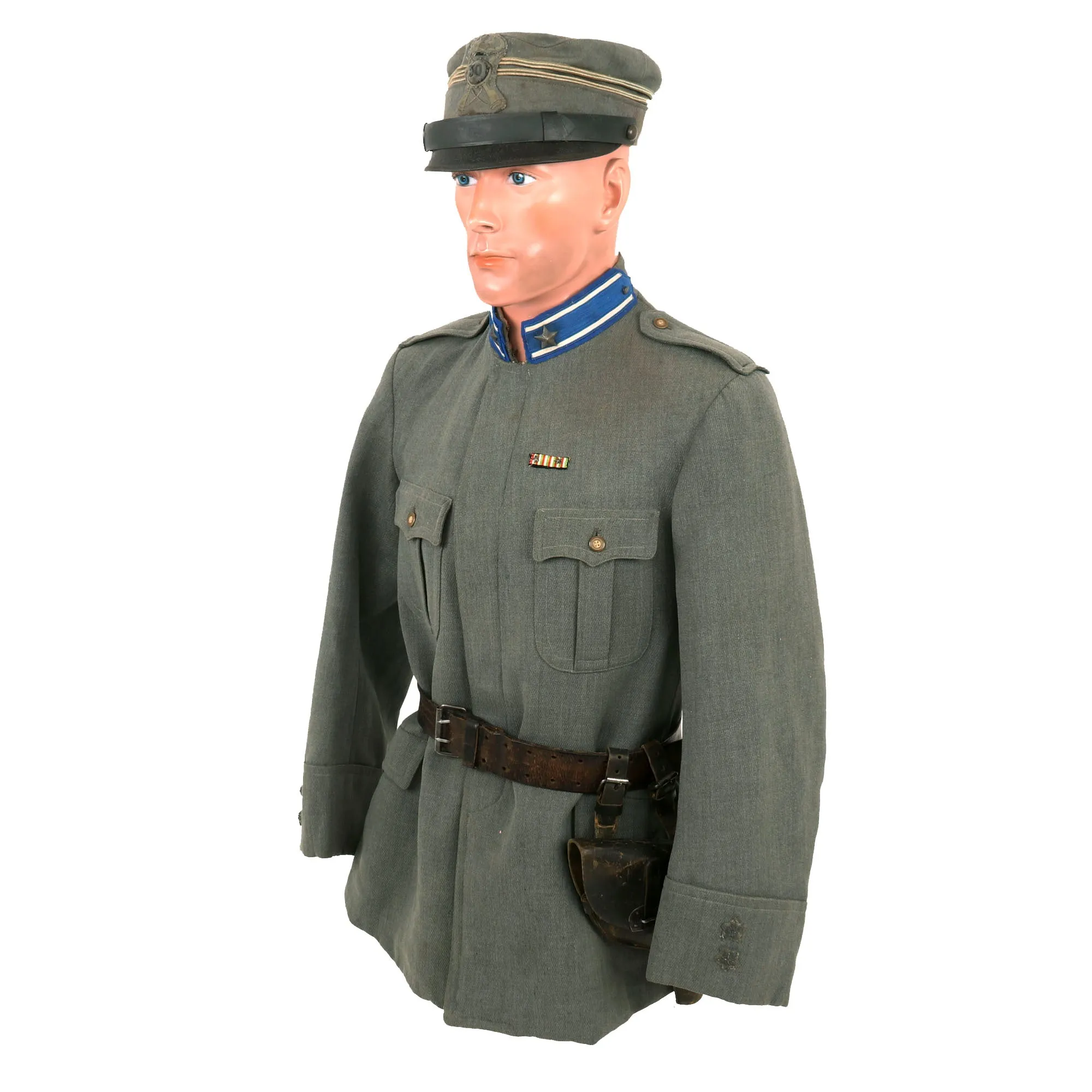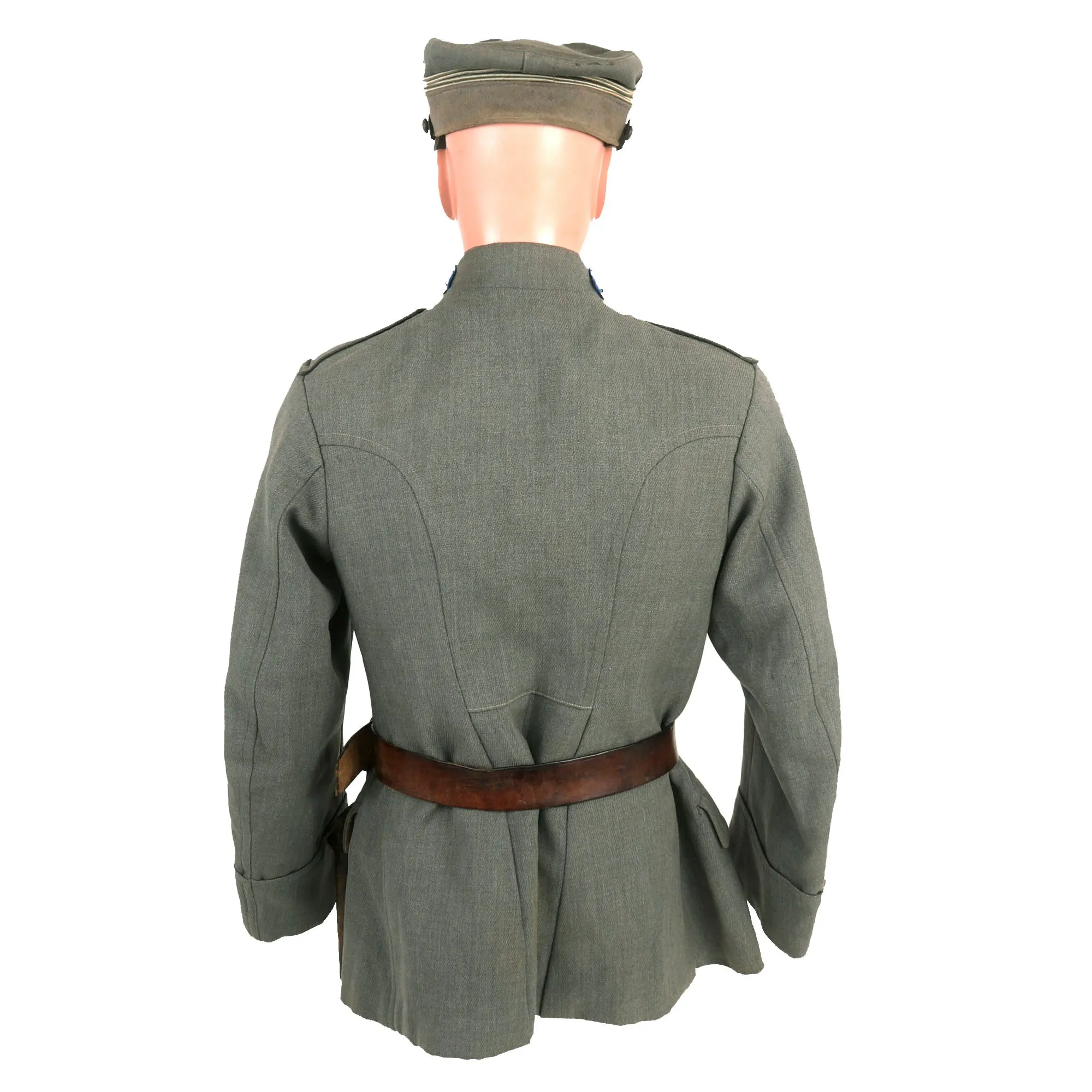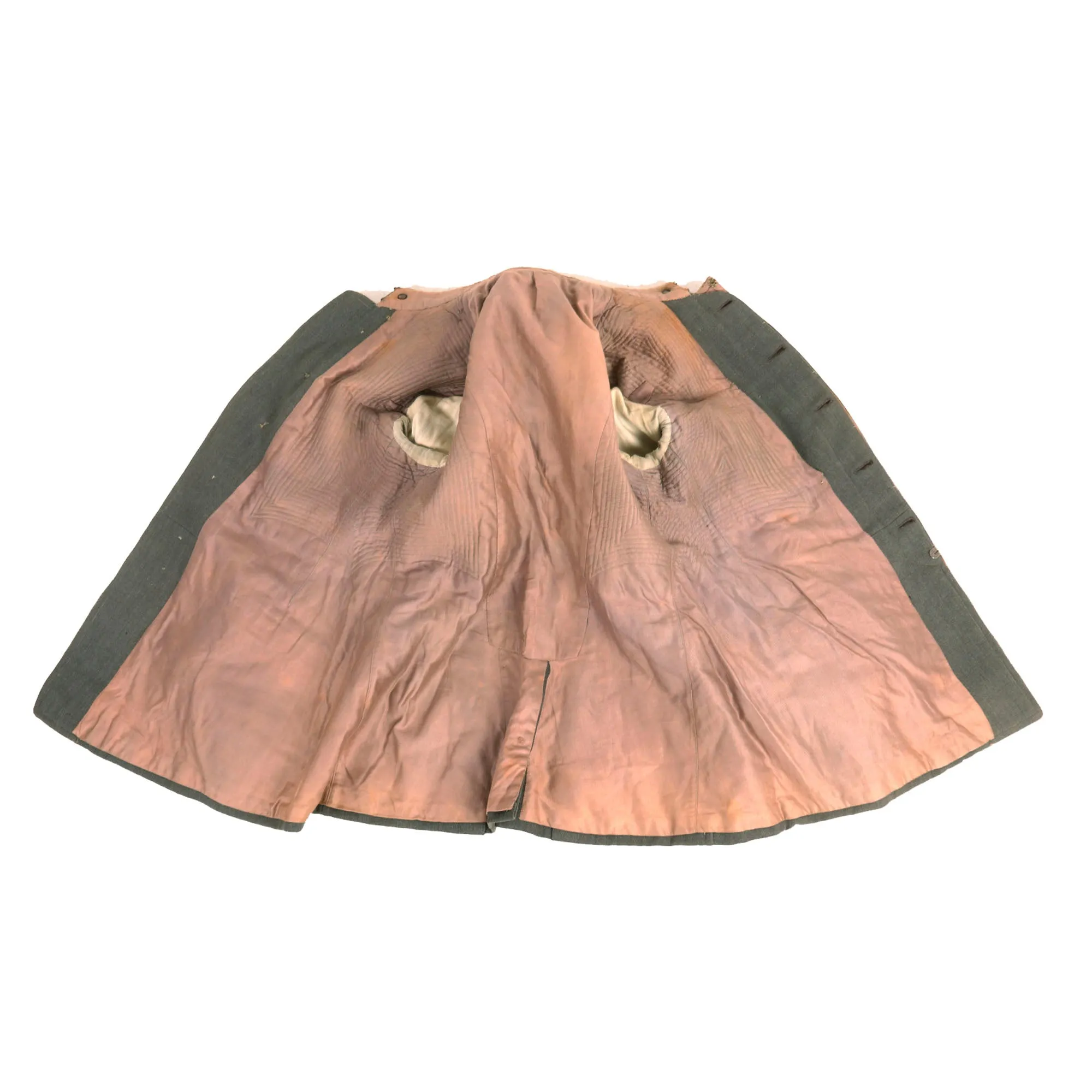Original Item: Only One Available: This is the most phenomenal WWI Italian Officer’s uniform grouping we have ever had. His tailored officer’s kepi is still in the delicate paper box. His tunic and breeches are the nicest we’ve seen with virtually no issues. There is very little in this grouping that could be upgraded. You likely won’t ever see another WWI Italian officer’s grouping as complete as this for sale.
This is the extensive uniform grouping of decorated Italian officer Captain Rodolfo Stiassi, 50th Infantry Regiment, Italian Army.
Captain Stiassi’s uniform has his rank denoted by two stars on his cuffs. This was the practice beginning in 1916. The two rows of braid on his kepi correspond to his cuff rank. The crossed rifles on his kepi badge further identify him as an infantry officer. Over his left breast pocket his tunic bears the ribbon awarded for the War of 1915-1918. The ribbon has two campaign stars attached. Captain Stiassi was also awarded the Italian War Merit Cross for meritorious service, which is included but not attached to the uniform.
The tunic is in phenomenal condition with both collar tabs still attached. There is very light mothing in isolated areas, virtually unnoticeable. The breeches are much the same, with all buttons still attached. Along with the tunic and breeches is his leather officer’s belt with his 1889 Bodeo holster attached.
The kepi is remarkably still in its original paper box as bought from the tailor, “CAPPELLERIA CIGNA TOMMASO Via Roma, N.25 TORINO”. You almost never see kepis of this quality, let alone with the original paper box. The kepi itself is in fantastic condition with no mothing present and the kepi badge still firmly affixed. There is Italian writing on the bottom of the box.
Also included is a photocopy of an original photograph of Captain Stiassi as well as a photograph of his Italian War Merit Cross certificate. An original War Merit Cross is also included for display.
Approximate Measurements:
Collar to shoulder: 9"
Shoulder to sleeve: 25”
Shoulder to shoulder: 15”
Chest width: 17.5"
Waist width: 19"
Hip width: 23"
Front length: 32"
Pants:
Waist: 16"
Inseam: 22"
The 50th Infantry Regiment, along with the 49th, was part of the “Parma” Brigade. The Parma Brigade was part of XII Corps, commanded by Lieutenant General Giuseppe Penella.
When Italy entered the war on May 23rd, 1915, 116 regiments of infantry were mobilized. The regiments were linked, or brigaded, in pairs. Of these 116 regiments, 94 were line infantry. The collar patch was created in brigade colors with the Star of Savoy on each. The Parma Brigade consisted of the 49th and 50th regiments and adopted blue with white stripes as their collar colors.
The Italian War Merit Cross
The Italian War Merit Cross was awarded to members of the armed forces with a minimum of one year's service in contact with an enemy, or who received the Medal of the Wounded, or to those who, when mentioned for war merit, received a promotion. Also, if an act of valor was deemed insufficient for the Medal of Military Valor, the War Merit Cross could be awarded instead; from 1922 onwards a bronze sword on the ribbon showed this class of award.
The War Merit Cross was in bronze, 38mm wide (1-1/2 inches). The reverse side bears a 5-pointed star on a background of rays. The obverse has the royal cypher ("VE III" under a crown) in the upper arm, "MERITO DI GVERRA" (War Merit) on the horizontal arms and a Roman sword point upwards, on oak leaves, in the lower arm. The ribbon is blue with white stripes. While the later originally were five within months they were reduced to two white stripes. Successive awards, three awardings being the maximum, were indicated by one or two bronze royal crowns. During World War II, the War Merit Cross underwent a number of significant changes. The number of awardings was limited to ten, indicated by a combination of bronze, silver and gold crowns. The medal received another change under the Italian Republic in 1947, the royal cypher being replaced by the intertwined letters "RI" for Repubblica Italiana. Limited to three awardings once again, with one cross or bar for every war allowed, multiple awards were shown by bronze stars. In the current form multiple awards are shown by silver stars.
Italy during World War I
Although a member of the Triple Alliance, Italy did not join the Central Powers – Germany and Austria-Hungary – when the war started with Austria-Hungary's declaration of war on Serbia on 28 July 1914. In fact, the two Central Powers had taken the offensive while the Triple Alliance was supposed to be a defensive alliance. Moreover the Triple Alliance recognized that both Italy and Austria-Hungary were interested in the Balkans and required both to consult each other before changing the status quo and to provide compensation for whatever advantage in that area: Austria-Hungary did consult Germany but not Italy before issuing the ultimatum to Serbia, and refused any compensation before the end of the war.
Almost a year after the war's commencement, after secret parallel negotiations with both sides (with the Allies in which Italy negotiated for territory if victorious, and with the Central Powers to gain territory if neutral) Italy entered the war on the side of the Allied Powers. Italy began to fight against Austria-Hungary along the northern border, including high up in the now-Italian Alps with very cold winters and along the Isonzo river. The Italian army repeatedly attacked and, despite winning a majority of the battles, suffered heavy losses and made little progress as the mountainous terrain favored the defender. Italy was then forced to retreat in 1917 by a German-Austrian counteroffensive at the Battle of Caporetto after Russia left the war, allowing the Central Powers to move reinforcements to the Italian Front from the Eastern Front.
The offensive of the Central Powers was stopped by Italy at the Battle of Monte Grappa in November 1917 and the Battle of the Piave River in May 1918. Italy took part in the Second Battle of the Marne and the subsequent Hundred Days Offensive in the Western Front. On 24 October 1918 the Italians, despite being outnumbered, breached the Austrian line in Vittorio Veneto and caused the collapse of the centuries-old Habsburg Empire. Italy recovered the territory lost after the fighting at Caporetto in November the previous year and moved into Trento and South Tyrol. Fighting ended on 4 November 1918. Italian armed forces were also involved in the African theatre, the Balkan theatre, the Middle Eastern theatre and then took part in the Occupation of Constantinople. At the end of World War I, Italy was recognized with a permanent seat in the League of Nations' executive council along with Britain, France and Japan.







































